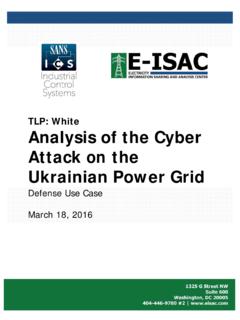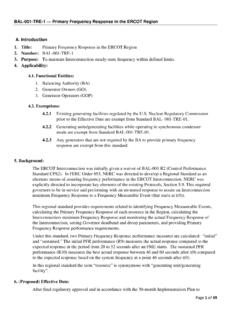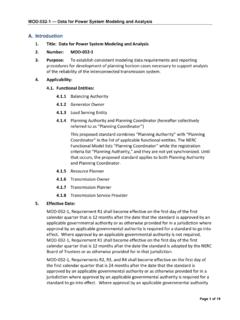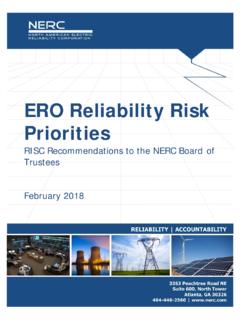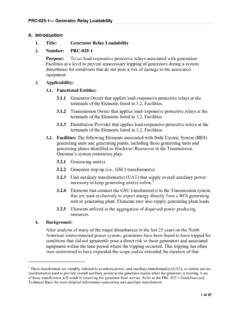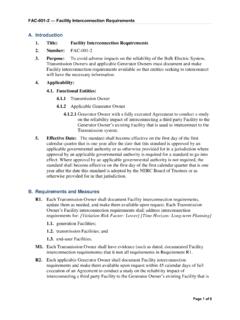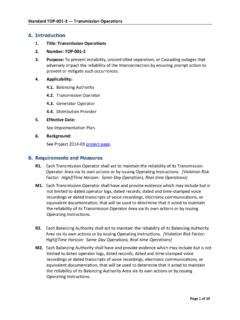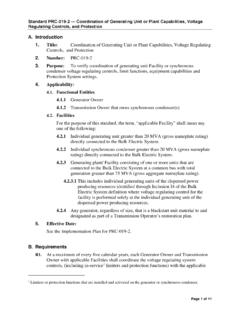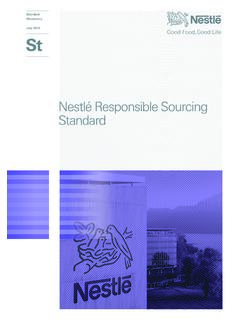Transcription of Cyber Security Supply Chain Risk Management Plans
1 ERO Enterprise-Endorsed Implementation Guidance. Endorsement for this implementation guidance is based on the language of draft 2 of the CIP-013-1 Reliability Standard dated April 2017. Any changes to the standard prior to the final ballot will require a reevaluation of the implementation guidance for continued endorsement. NERC | Report Title | Report Date I Cyber Security Supply Chain Risk Management Plans Implementation Guidance for CIP-013-1 NERC | CIP-013-1 Implementation Guidance | Draft: April 2017 ii Table of Contents Introduction .. iii Requirement R1 ..1 General Considerations for R1 ..1 Implementation Guidance for R1 ..2 Requirement R2 ..8 General Considerations for R2 ..8 Requirement R3 ..9 General Considerations for R3 ..9 Implementation Guidance for R3 ..9 References .. 10 NERC | CIP-013-1 Implementation Guidance | Draft: April 2017 iii Introduction On July 21, 2016, the Federal Energy Regulatory Commission (FERC) issued Order No.
2 829 directing the North American Electric Reliability Corporation (NERC) to develop a new or modified Reliability Standard that addresses Cyber Security Supply Chain risk Management for industrial control system hardware, software, and computing and networking services associated with Bulk Electric System (BES) operations as follows: [The Commission directs] NERC to develop a forward-looking, objective-based Reliability Standard to require each affected entity to develop and implement a plan that includes Security controls for Supply Chain Management for industrial control system hardware, software, and services associated with bulk electric system operations. The new or modified Reliability Standard should address the following Security objectives, [discussed in detail in the Order]: (1) software integrity and authenticity; (2) vendor remote access; (3) information system planning; and (4) vendor risk Management and procurement controls.
3 Reliability Standard CIP-013-1 Cyber Security Supply Chain Risk Management addresses the relevant Cyber Security Supply Chain risks in the planning, acquisition, and deployment phases of the system life cycle for high and medium impact BES Cyber Systems1. This implementation guidance provides considerations for implementing the requirements in CIP-013-1 and examples of approaches that responsible entities could use to meet the requirements. The examples do not constitute the only approach to complying with CIP-013-1. responsible Entities may choose alternative approaches that better fit their situation. 1 responsible Entities identify high and medium impact BES Cyber Systems according to the identification and categorization process required by CIP-002-5, or subsequent version of that standard.
4 NERC | CIP-013-1 Implementation Guidance | Draft: April 2017 1 Requirement R1 R1. Each responsible Entity shall develop one or more documented Supply Chain Cyber Security risk Management plan(s) for high and medium impact BES Cyber Systems. The plan(s) shall include: One or more process(es) used in planning for the procurement of BES Cyber Systems to identify and assess Cyber Security risk(s) to the Bulk Electric System from vendor products or services resulting from: (i) procuring and installing vendor equipment and software; and (ii) transitions from one vendor(s) to another vendor(s). One or more process(es) used in procuring BES Cyber Systems that address the following, as applicable: Notification by the vendor of vendor-identified incidents related to the products or services provided to the responsible Entity that pose Cyber Security risk to the responsible Entity; Coordination of responses to vendor-identified incidents related to the products or services provided to the responsible Entity that pose Cyber Security risk to the responsible Entity; Notification by vendors when remote or onsite access should no longer be granted to vendor representatives; Disclosure by vendors of known vulnerabilities; Verification of software integrity and authenticity of all software and patches provided by the vendor for use in the BES Cyber System.
5 And Coordination of controls for (i) vendor-initiated Interactive Remote Access, and (ii) system-to-system remote access with a vendor(s). General Considerations for R1 The following are some general considerations for responsible Entities as they implement Requirement R1: First, in developing their Supply Chain Cyber Security risk Management plan(s), responsible entities should consider how to leverage the various components and phases of their processes ( defined requirements, request for proposal, bid evaluation, external vendor assessment tools and data, third party certifications and audit reports, etc.) to help them meet the objective of Requirement R1 and give them flexibility to negotiate contracts with vendors to efficiently mitigate risks. Focusing solely on the negotiation of specific contract terms could have unintended consequences, including significant and unexpected cost increases for the product or service or vendors refusing to enter into contracts.
6 Additionally, a responsible Entity may not have the ability to obtain each of its desired Cyber Security controls in its contract with each of its vendors. Factors such as competition, limited Supply sources, expense, criticality of the product or service, and maturity of the vendor or product line could affect the terms and conditions ultimately negotiated by the parties and included in a contract. This variation in contract terms is anticipated and, in turn, the note in Requirement R2 provides that the actual terms and conditions of the contract are outside the scope of Reliability Standard CIP-013-1. Note: Implementation of the plan does not require the responsible Entity to renegotiate or abrogate existing contracts (including amendments to master agreements and purchase orders). Additionally, the Requirement R1 NERC | CIP-013-1 Implementation Guidance | Draft: April 2017 2 following issues are beyond the scope of Requirement R2: (1) the actual terms and conditions of a procurement contract; and (2) vendor performance and adherence to a contract.
7 The focus of Requirement R1 is on the steps the Responsibility Entity takes to consider Cyber Security risks from vendor products or services during BES Cyber System planning and procurement. In the event the vendor is unwilling to engage in the negotiation process for Cyber Security controls, the responsible Entity could explore other sources of Supply or mitigating controls to reduce the risk to the BES Cyber systems, as the responsible Entity s circumstances allow. In developing and implementing its Supply Chain Cyber Security risk Management plan, a responsible Entity may consider identifying and prioritizing Security controls based on the Cyber Security risks presented by the vendor and the criticality of the product or service to reliable operations. For instance, responsible Entities may establish a baseline set of controls for given products or services that a vendor must meet prior to transacting with that vendor for those products and services ( , must-have controls ).
8 As risks differ between products and services, the baseline Security controls or must haves may differ for the various products and services the responsible Entities procures for its BES Cyber Systems. This risk-based approach could help create efficiencies in the responsible Entity s procurement processes while meeting the Security objectives of Requirement R1. The objective of addressing the verification of software integrity and authenticity during the procurement phase of BES Cyber System(s) (Part ) is to identify the capability of the vendor(s) to ensure that the software installed on BES Cyber System(s) is trustworthy. Part is not an operational requirement for responsible Entities to perform the verification; instead, Part is aimed at identifying during the procurement phase the vendor s capability to provide software integrity and authenticity assurance and establish vendor performance based on the vendor s capability in order to implement CIP-010-3, Requirement R1, Part Implementation Guidance for R1 responsible entities use various processes as they plan to procure BES Cyber Systems.
9 Below are some examples of approaches to comply with this requirement: R1. Each responsible Entity shall develop one or more documented Supply Chain Cyber Security risk Management plan(s) for high and medium impact BES Cyber Systems. The plan(s) shall include: The responsible Entity could establish one or more documents explaining the process by which the responsible Entity will address Supply Chain Cyber Security risk Management for high and medium impact BES Cyber Systems. To achieve the flexibility needed for Supply Chain Cyber Security risk Management , responsible Entities can use a risk-based approach . One element of, or approach to, a risk-based Cyber Security risk Management plan is system-based, focusing on specific controls for high and medium impact BES Cyber Systems to address the risks presented in procuring those systems or services for those systems.
10 A risk-based approach could also be vendor-based, focusing on the risks posed by various vendors of its BES Cyber Systems. Entities may combine both of these approaches into their Plans . This flexibility is important to account for the varying needs and characteristics of responsible entities and the diversity of BES Cyber System environments, technologies, and risk (FERC Order No. 829 P 44). One or more process(es) used in planning for the procurement of BES Cyber Systems to identify and assess Cyber Security risk(s) to the Bulk Electric System from vendor products or services resulting from: (i) procuring and installing vendor equipment and software; and (ii) transitions from one vendor(s) to another vendor(s). Requirement R1 NERC | CIP-013-1 Implementation Guidance | Draft: April 2017 3 A responsible Entity could document in its Supply Chain Cyber Security risk Management plan one or more processes that it will use when planning for the procurement of BES Cyber Systems to identify and assess Cyber Security risks to the Bulk Electric System from vendor products or services as specified in the requirement.
